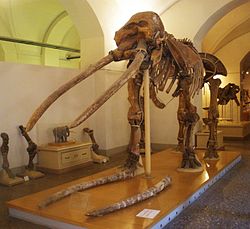Anancus
| Anancus | |||
|---|---|---|---|
 Auvergnemastodont i det
naturhistoriske museet i Firenze | |||
| Nomenklatur | |||
| Anancus Aymard, 1855 | |||
| Klassifikasjon | |||
| Rike | dyr | ||
| Rekke | ryggstrengdyr | ||
| Klasse | pattedyr | ||
| Orden | snabeldyr | ||
| Overfamilie | Elephantoidea | ||
| Alder | sein miocen–tidlig pleistocen | ||
| Økologi | |||
| Utbredelse: | Eurasia, Afrika | ||
| Inndelt i | |||
|
se egen seksjon | |||
Anancus er ei utdødd slekt med snabeldyr.
To mer eller mindre komplette skjeletter av Anancus arvernensis viser at arten nådde opp til omkring 2,5-2,6 m over skuldrene, med en estimert vekst på 5,2 to 6 tonn, tilsvarende en moderne afrikansk elefant.[1] Støttennene var ganske rette og manglet emalje[1] (selv om tennene til unge dyr hadde en del elemaje[2]) og var ganske slanke, og kunne bli 3 m lange.[2] Støttennene varierte mellom å være parallelle og peke rett fram, til å være krummet utover fra hverandre, avhengig av art.[3] Hodeskallen var kort og høy, med en tydelig utbuling over pannen og store bulla tympanica. I motsettning til de mer primitive gompotherene var underkjeven kort og bred, og manglet tilløp til underkjevestøttenner.
Jekslene var tydelig tetralophodonte (med fire forhøyninger på tvers av tyggeflaten), med forhøyningene mer eller mindre delt opp i enkeltkuler. Enkelte av artene kunne ha en ekstra tverrgående forhøyning (pentalophodonte). Forjekslene manglet hos alle artene, bortsett fra hos A. kenyensis.[4]
Galleri
[rediger | rediger kilde]-
Rekonstruksjon av auvergnemastodont, Anancus arvernensis
-
Kjeve
-
Skallen til Anancus sivalensis, sett fra siden
Referanser
[rediger | rediger kilde]- ^ a b Romano, Marco; Bellucci, Luca; Antonelli, Matteo; Manucci, Fabio; Palombo, Maria Rita (13. juni 2023). «Body mass estimate of Anancus arvernensis (Croizet and Jobert 1828): comparison of the regression and volumetric methods». Journal of Quaternary Science. doi:10.1002/jqs.3549.
- ^ a b Theodorou, G., Spjeldnaes, N., Hanken, N. M., Lauritzen, S. E., Velitzelos, E., Athanassiou, A., et al. (2000). Description and taphonomic investigations of Neogene Proboscidea from Rhodos, Greece. Annales Géologiques des Pays Helléniques, 38, 133–156.
- ^ Konidaris, George E.; Roussiakis, Socrates J. (2. november 2018). «The first record of Anancus (Mammalia, Proboscidea) in the late Miocene of Greece and reappraisal of the primitive anancines from Europe». Journal of Vertebrate Paleontology. 38 (6): e1534118. doi:10.1080/02724634.2018.1534118.
- ^ Konidaris, George E.; Roussiakis, Socrates J. (2. november 2018). «The first record of Anancus (Mammalia, Proboscidea) in the late Miocene of Greece and reappraisal of the primitive anancines from Europe». Journal of Vertebrate Paleontology. 38 (6): e1534118. Bibcode:2018JVPal..38E4118K. doi:10.1080/02724634.2018.1534118.
Litteratur
[rediger | rediger kilde]- Guiomar Garrido og Alfonso Arribas (2014). «The last Iberian gomphothere (Mammalia, Proboscidea): Anancus arvernensis mencalensis nov. ssp. from the earliest Pleistocene of the Guadix Basin (Granada, Spain)». Palaeontologia Electronica. 17.1.4A. doi:10.26879/387.
- Patricia A.Groenewald m.fl. (2020). «Dietary resource partitioning among three coeval proboscidean taxa (Anancus capensis, Mammuthus subplanifrons, Loxodonta cookei) from the South African Early Pliocene locality of Langebaanweg E Quarry». Palaeogeography, Palaeoclimatology, Palaeoecology. 543. ISSN 0031-0182. doi:10.1016/j.palaeo.2020.109606.
- F. Rivals, D. Mol, F. Lacombat, A.M.Lister og G.M. Semprebon (2015). «Resource partitioning and niche separation between mammoths (Mammuthus rumanus and Mammuthus meridionalis) and gomphotheres (Anancus arvernensis) in the Early Pleistocene of Europe». Quaternary International. 379: 164–170. ISSN 1040-6182. doi:10.1016/j.quaint.2014.12.031.
Eksterne lenker
[rediger | rediger kilde]- (en) Anancus i Encyclopedia of Life
- (en) Anancus i Global Biodiversity Information Facility
- (en) Anancus hos Fossilworks
- (en) Kategori:Anancus – bilder, video eller lyd på Wikimedia Commons
- Anancus – detaljert informasjon på Wikispecies
Text is available under the CC BY-SA 4.0 license; additional terms may apply.
Images, videos and audio are available under their respective licenses.



